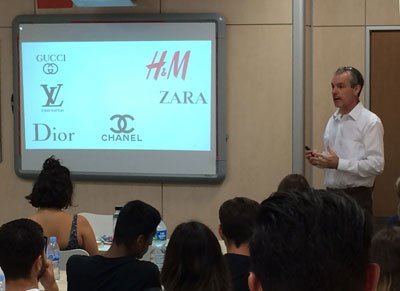Fast-fashion and multichannel: the future of fashion industry
published on 20.07.17
Interview with fashion marketing specialist Jean Marc Rejaud
Jean Marc Rejaud, professor at the Fashion Institute of Technology in New York. He has been teaching Fashion & Luxury Management at TBS Barcelona’s Summer School.
With the birth of fast-fashion brands, the impact of digital, etc. where is the fashion industry headed? I am particularly interested in luxury brands.
J. M. Rejaud: Due to the pressures of a digital and multichannel world, luxury brands will split into two branches: absolute luxury brands and affordable luxury brands. It will be more difficult for the absolute luxury brands, like Yves Saint Laurent, to adapt to the digitalisation of communication and interaction, and the acceleration of design and production. But before long we will see luxury brands producing many more than four collections per year.
But aren’t fast-fashion and luxury contradictory concepts?
J. M. Rejaud: The concept of fast-fashion simply means an acceleration of the 4-5 collections per year fashion production cycle. It has been associated with low-end brands since companies like H&M and ZARA came onto the scene. ZARA is on the other extreme of fast-fashion and produces a new collection every two weeks. Nevertheless, the concept of fast-fashion or quick product cycles can be applied to luxury. In fact, the limited edition format simultaneously fits perfectly with both fast-fashion and luxury. Brands are currently applying fast-fashion to luxury, and they will get there for sure.
The brand expert Scott Galloway said “Amazon has conspired with consumers and technology to destroy brands”, and now Amazon is the number-one seller in the fashion industry. Why? How does Amazon affect fashion brands?
J. M. Rejaud: It’s true that Amazon has changed the rules of the game. You can access better things, at better prices, instantaneously. Amazon is disruptive for the benefit of consumers and disruptive in a negative way for fashion brands, as they can no longer play by the same rules that they used to. Either they avoid the Amazon issue, which will cause them to suffer, or they try to understand what is going on and adapt. For instance, Amazon cannot provide a customer-service experience, so maybe they should focus on a customer-service experience that can’t be reproduced online.
Are there luxury brands that are updating themselves in this way?
J. M. Rejaud: Burberry is a luxury brand that is doing very well: they have begun to prioritise customer experience while at the same time embracing ecommerce. Gucci is getting there as well. Burberry made a deal with Amazon, so the digital giant is cleaning the grey market of Burberry products and in exchange they are able to sell Burberry products officially. Smart! How can you not be on Amazon if you are in fashion and luxury?
Digitally, Burberry has been the best performing luxury brand for several years.
J. M. Rejaud: Yes, they have a research boutique, L2 think-tank, and a scoring methodology to review the digital marketing performance of brands. As a matter of fact, the former CEO of Burberry moved to Amazon, where she built up its fashion area to become the current number-one fashion seller.
In one of your lectures you mentioned that the management of ZARA is not completely marketing driven, and that it was governed by more traditional management. How so?
J. M. Rejaud: Marketing-driven management places customers at the centre. ZARA is still designer driven rather than customer driven, they have an army of designers in their headquarters copying and adapting the latest trends. Advertising, for instance, is not one of their major priorities; ZARA is not marketing driven at all in this sense. But because they do a lot of consumer research, have a great sense of habit changing and a great feedback loop from their shops to their headquarters, in this sense they are marketing driven. In conclusion, I would say that they are not marketing-communication driven.
But it is hard to believe that there are still fashion companies that do not place the customer at the centre, isn’t it?
J. M. Rejaud: For many companies, the designer is placed in the centre and everything else is built around the designer, they are the be-all and end-all of the business, and what the designer thinks or says affects everything. A business can be started like that, with a visionary who has great talent. But eventually, the customers’ needs have to drive the company. And this goes for any kind of company. I am sure that when Steve Jobs launched Apple he would have said that the most important thing was the technology, the engineering; but at the end of his life, he would have said customers, customers’ needs and customer experience.
Can you point to an example of this in the fashion industry?
J. M. Rejaud: Designer Michael Kors understands this very well. Which is why his brand has become so big despite being very young; he does not put his designer ego at the centre and understands that he is in a customer-related business. In contrast, Ralph Lauren is firing CEO after CEO because he has problems making this step.
Now, I would like you to highlight the performance of one brand that is interesting from the point of view of a marketer or a manager.
J. M. Rejaud: Now that casual wear and sportswear have become the latest trend in the fashion market, I think that the performance of the Under Armour brand is worth highlighting as it is the only sports brand, other than Nike, that is growing. Of course, Under Armour is still a dwarf compared to Nike, but they are the only brand that is actually growing. I think this is due to the fact that they are strictly customer driven. They work for a very well-known target and have a coherent message, product and distribution.
Tags: fashion & luxury|fashion industry|management|marketing|Summer School


